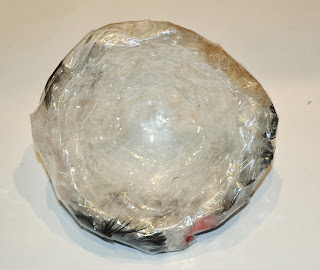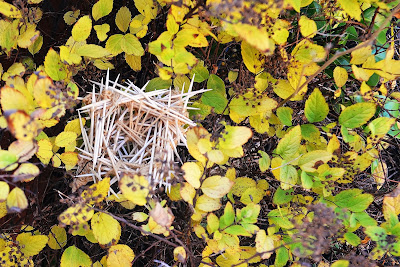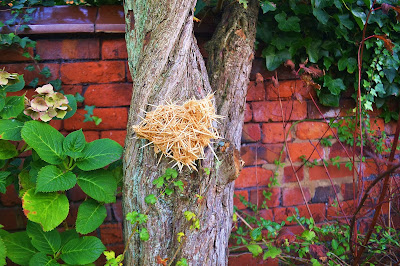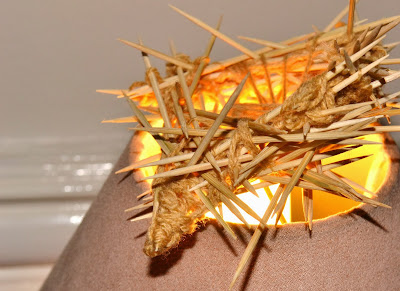I chose to base this project around the Mobile Habitats brief, which asks you to consider how the idea of a mobile habitat might be realised through art and design solutions with particular emphases on the role that textiles might play. From early on in the project, I decided to look at two very interesting interior designers who based their furniture designs on the shapes of animals, and from here I had knew that I wanted to design something that was for an interior, so the idea of furniture has been in the back of my mind through out this project.
I have enjoyed this project, even though I feel I got off to a slow start, I think that I have managed to come up with some interesting designs that represent the idea of a mobile habitat. In an ideal world I would have liked to have made something bigger, and that in itself is progress to me, because I was quite scared of making something on a large scale, and now I wouldn't mind experimenting more with larger sized designs.
I think that this project has taught me that I am a 3D worker, I have a 3D mind that likes to experiment with different textures and surfaces, and I shouldn't hold myself back from doing that because I'm worried I won't finish something.
I really like the objects that I've made from the inspiration of nests, and I wish I'd had the idea earlier on in the project so I could experiment with more ways of creating nests. I think it would have been a nice idea to have manipulated the fabric first, or decorated it myself with the different embroidery techniques I'd learned earlier in the project, such as the embroidered ants or bees.
Overall I am happy with my designs, because they have a function. You can sit on the chair and you can put things in the bowl. For this project, at first I wanted to make something that was multi functional but due to my slow start which lead to me being restricted of time I have had to settle for something that is just functional!
Interior design is definitely the direction I wanted this project to go in, but I think my knowledge of interior designers still needs to be improved, because I found it so hard exploring different designers in this project. I felt as though I was flicking through loads that didn't have any relevance to my project.
This project has also made me realise how important the tutorials are. My work wouldn't have developed how it did if I hadn't seen it from different perspectives.
Making my designs
I found the making parts to be the most fun in a project. I have used chicken wire to form the bases of my designs, and then I have used the rag rug technique to create a textured surface. The wire scratched me a lot, and I probably could have saved a bit of time if I had cut all of the strips of fabric the same length so I didn't have to trim the design at the end.
When I was looking at different rag rug designs, I found a few that were woven by using a plain weave, so I have included some plain weave sections in my strip to make the knotted sections more spaced out.
What I've made:
When I was looking at different rag rug designs, I found a few that were woven by using a plain weave, so I have included some plain weave sections in my strip to make the knotted sections more spaced out.
What I've made:
Nest bowl
Thinking more about designs
I haven't really got a lot of time to start making something massive and amazing, so instead I have drawn out a range of designs that I think would be a good way to demonstrate how nests can be transferred into interior designs. A few of me designs include a plain surface, with a statement strip of knotted or tied fabric, down the centre. The texture and colours of this fabric have been inspired by nests. This has got me thinking that I am actually designing a surface pattern that can be used to go over an existing object, to get the feel of what the real thing would look like.
I have experimented with a few ways of weaving in my technical file, but I really like one of the first ways I tried, that involves attaching strips of fabric around a surface by creating a slip knot. This technique is used quite often when making old fashioned rag rugs, and I thought that using this technique would reflect my use of recycling fabric quite well, because they are associated with making use of old clothes and other pieces of cloth that were seen as unable to continue in their normal use. I found out that rag rugs were usually made out of wool or flax, which were two precious materials were the most commonly found in rag rugs. These materials take a long time to be produced so they couldn't be wasted. Every household would use rag rugs to protect their floor, keep it clean and to prevent drafts. A new rag rug would be made every year, and the older ones would be rotated around the house, and the door mat would either be thrown away or used to protect vegetables on the vegetable patch.
This technique also means that one side will be really textured and fluffy, and the other side would be fairly flat, and only slightly uneven, but all of the base material would be covered, so I could use a stiff materials such a wire mesh and mould the surface around an object, to give it a different appearance.
I have experimented with a few ways of weaving in my technical file, but I really like one of the first ways I tried, that involves attaching strips of fabric around a surface by creating a slip knot. This technique is used quite often when making old fashioned rag rugs, and I thought that using this technique would reflect my use of recycling fabric quite well, because they are associated with making use of old clothes and other pieces of cloth that were seen as unable to continue in their normal use. I found out that rag rugs were usually made out of wool or flax, which were two precious materials were the most commonly found in rag rugs. These materials take a long time to be produced so they couldn't be wasted. Every household would use rag rugs to protect their floor, keep it clean and to prevent drafts. A new rag rug would be made every year, and the older ones would be rotated around the house, and the door mat would either be thrown away or used to protect vegetables on the vegetable patch.
This technique also means that one side will be really textured and fluffy, and the other side would be fairly flat, and only slightly uneven, but all of the base material would be covered, so I could use a stiff materials such a wire mesh and mould the surface around an object, to give it a different appearance.
My tutoiral & contextualising my work
I found my tutorial really helpful this week. I wanted to see how I could create objects that could be used in an interior space, that relate to nests. I want to create something with a function and I have been finding it hard to research other designers that create furniture in the same form as nests.
Fiona suggested that I look at the Camparna Brothers, and I thought their work related really well to the finding form lecture Fiona had given us. The Camparna Brothers use repetitive forms to create or decorate solid structures such as chairs. The materials they use in their designs range from strips of fabric to cuddly toys.
Fiona also suggested that I look at Tokujin Yoshiaka, who uses interesting and innovative materials to create designs for chairs. I think that the ones I found most interesting was firstly where he grew a chair out of crystals. I have never seen anything grown out of crystals, so I found this design really interesting. He also designed a chair out of crumpled pieces of paper which I thought was very different but not entirely functional.
I have also found some designers of my own, such as Emily Pillston, who created a piece called The Human Nest. This piece was created by weaving and tying fabric around a bamboo chair. I thought the idea of a human nest was really interesting, however I thought it looked a bit too messy with all the different coloured fabric stretched out in different directions.
I have also looked at different designs that have originated from nests, and I have found a set of stairs in a house in France, that were inspired by the structure of a nest, a phone cover, the 2008 Beijing Olympic Stadium, and a range of chairs.
What I have noticed is that the materials used in the interior designs are usually the opposite to those found in a bird's nest. The materials used are fabric and metal, I have researched one by the Camparna Brothers that's made of wood, however the pieces of wood are cut into thin blocks and sanded so they look fairly unnatural themselves.
This will be because people don't want a messy looking piece of furniture in their homes, that's made out of found sticks and leaves from the outdoors. For my design, I am also going to use man made materials, to give a cleaner appearance, but also to experiment more with the idea of a human nest, made out of materials made by people.
I would, however live to stick to recycled materials because I feel this represents the idea of a nest more than shop bought fabrics.
Fiona suggested that I look at the Camparna Brothers, and I thought their work related really well to the finding form lecture Fiona had given us. The Camparna Brothers use repetitive forms to create or decorate solid structures such as chairs. The materials they use in their designs range from strips of fabric to cuddly toys.
Fiona also suggested that I look at Tokujin Yoshiaka, who uses interesting and innovative materials to create designs for chairs. I think that the ones I found most interesting was firstly where he grew a chair out of crystals. I have never seen anything grown out of crystals, so I found this design really interesting. He also designed a chair out of crumpled pieces of paper which I thought was very different but not entirely functional.
I have also found some designers of my own, such as Emily Pillston, who created a piece called The Human Nest. This piece was created by weaving and tying fabric around a bamboo chair. I thought the idea of a human nest was really interesting, however I thought it looked a bit too messy with all the different coloured fabric stretched out in different directions.
I have also looked at different designs that have originated from nests, and I have found a set of stairs in a house in France, that were inspired by the structure of a nest, a phone cover, the 2008 Beijing Olympic Stadium, and a range of chairs.
What I have noticed is that the materials used in the interior designs are usually the opposite to those found in a bird's nest. The materials used are fabric and metal, I have researched one by the Camparna Brothers that's made of wood, however the pieces of wood are cut into thin blocks and sanded so they look fairly unnatural themselves.
This will be because people don't want a messy looking piece of furniture in their homes, that's made out of found sticks and leaves from the outdoors. For my design, I am also going to use man made materials, to give a cleaner appearance, but also to experiment more with the idea of a human nest, made out of materials made by people.
I would, however live to stick to recycled materials because I feel this represents the idea of a nest more than shop bought fabrics.
More nests
So I've made a range of nests out of different materials...
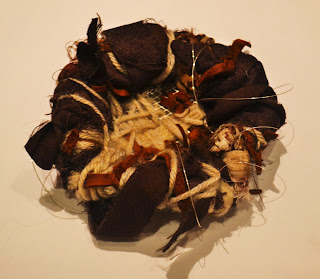 |
| Mesh, wire, leather, wool, fabric |
 |
| Sticky tape, wool, net |
 |
| Plastic material, feathers, paper fasteners |
 |
| Leather, paper fasteners, wire, wool |
 |
| Wire mesh, wool, feathers |
 |
| Sticky tape, feathers |
 |
| Wire mesh, toothpicks,wool, fabric |
 |
| Wool, wire, feathers |
 |
| Wire mesh, wire, net, fabric |
Tutorial
Unfortunately for this tutorial, Fiona was ill, so the university provided a substitute tutor to help us out this time. I found her input really useful. She suggested combining my machine embroidery work with the 3D nests, and to create lots of samples for next week. She also reminded me to contextualize my work more, and at the moment I'm torn between creating a piece of work that reflects the homes of animals, or actually making something with a function. If I make something that looks good whilst being functional then I suppose I'd have the best of both worlds. The idea that's on my mind at the moment is creating something that can be used as for storing things in, but I'm not too sure if my project could be that simple. I got this idea from reading the brief over and over, and because I've ended up focusing on the part that says '...cultural and political changes challenging us to reconsider the ways that we live, how we occupy space and the impact that we have on the world around us' it's got me thinking how I occupy my own space. I am constantly needing more storage. I literally have so much stuff, it's everywhere. My belongings cover most of the surfaces in my flat, and are placed under everything that has a space between itself and the floor. I noticed when I went back home this weekend that my parent's house isn't cluttered at all, and they have a lot of furniture that's sole purpose is storage.
Spider's Web
I attempted to make my own spider's web by using thread wrapped around nails. This wasn't as fiddly as I thought it would be and I think I could use this idea combined with the bird's nests to create something really interesting. I also used a hot glue gun to create a dew-like appearance over the thread.
I then put the log I used back where I found it and I am really impressed with the photos
Photos of my Nests
I was a bit stuck with what to do with my toothpick and wool nests once I'd made them, so I decided to take some photos of them in different places to see what different effects it could create. I got this idea from when I looked at Slinkachu earlier in the project, where he took a snail out of it's environment, changed it, then photographed it again. But for my project, I've got a nest, and recreated it and put it back in its environment to see what it'll look like.
I then went onto taking photos of the nests in unexpected environments because at the moment, my project isn't exciting me. I thought that a change of background might make it look more interesting, but to be honest, I think I've made my nests out of boring materials. I am going to broaden my use of materials so that I will have a variety to develop my ideas from.
Nest Research
Before I continue to elaborate on my 3D work, I thought it would be really useful to see what different kinds of nests I can find locally. I didn't have to go far to find these, as most of them were in my back garden. I think it's really interesting to see how different creatures make their homes, and I hope this will inspire me to make some really creative pieces.
The first nest I found belonged to a Solitary Bee. This is about the same size as a gold ball and is made out of a paper-like material created when the bees chew wood or plant matter, mixing it with their saliva to form a paste. I was really impressed when I found this, and I thought the shape of it was really clever. The rim around the top sticks out on purpose, and its job is to stop the rain from getting in. There was nothing living in it when I found it, and it'd been abandoned for about 2 months so I've decided that I'm going to have a go at seeing what's inside later in the week.
Woodworm
I think that woodworm create really interesting structures by eating away at the wood because they create a sanded-down appearance of where they've eaten, so there aren't any jagged corners or rough edges. With this branch, it looks as though they've eaten as much as possible but kept as much of the outer structure as possible. I really like the colours revealed as they get further into the branch.
The first nest I found belonged to a Solitary Bee. This is about the same size as a gold ball and is made out of a paper-like material created when the bees chew wood or plant matter, mixing it with their saliva to form a paste. I was really impressed when I found this, and I thought the shape of it was really clever. The rim around the top sticks out on purpose, and its job is to stop the rain from getting in. There was nothing living in it when I found it, and it'd been abandoned for about 2 months so I've decided that I'm going to have a go at seeing what's inside later in the week.
Spider's web & nest
I didn't want to get too close because I don't really like spiders. I think their web's are amazing though because of how delicate they look, and how effective they are. I also think that I should try and relate my work more to a web because thread is literally used in the making of it.
Woodworm
I think that woodworm create really interesting structures by eating away at the wood because they create a sanded-down appearance of where they've eaten, so there aren't any jagged corners or rough edges. With this branch, it looks as though they've eaten as much as possible but kept as much of the outer structure as possible. I really like the colours revealed as they get further into the branch.
Birds nests
I don't know what kind of birds these belonged to, but I'm assuming that most of them are black birds. I like the idea that a nest isn't a permanent structure, which it looked after and maintained when the bird is using it, and once it's use has ended, the nest will disintegrate and just blow away. I also think that the different textures used can be represented more in my work, through the use of hard and soft materials.
Subscribe to:
Comments (Atom)









